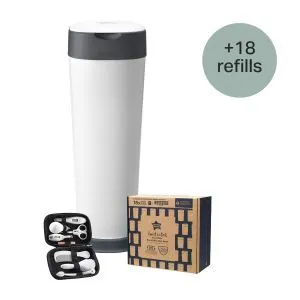
Ultimate XL Nappy Disposal Bundle with 18 Refills
Bundle & Save 40%
Subscription orders can be cancelled at anytime. Free delivery on all subsequent subscription orders. Find out more about subscriptions.
They’re easy and fuss free
Your products are automatically sent to you
You save up to 10% when you sign up for a subscription
You can cancel at any time

The process of baby teeth coming in can be tough. If your baby is drooling and chewing everything, you need teething toys. But which ones are best?
This guide will help you pick the perfect teether to help soothe your baby's sore gums and distract them from teething pains.
It's normal for parents to wonder when the right time is to introduce teething toys into their baby’s routine.
At around 3 to 6 many babies start showing signs of teething, like increased drooling, chewing on hands or other objects, and fussiness because of swollen or tender gums.
It's helpful to introduce teethers early, even before teeth appear, to help babies get accustomed to them. Even before the first tooth erupts, teething toys can help soothe sore gums and provide oral stimulation.
At this age, babies are also developing hand and eye coordination, and the ability to grab and hold items, so a teether can be a very helpful tool to help them reach the next developmental milestone.
Explore the Range
Many teething toys – like our teething rings – are made of firm rubber or silicone and come in various shapes and sizes. They're durable and easy to clean, making them a reliable choice. Many classic teethers feature textured surfaces to provide extra gum stimulation.
These teethers are filled with non-toxic gel and can be chilled in the fridge to help soothe inflamed gums. The instructions that come with the ring should tell you how long to chill it for. Never put a teething ring in the freezer, as it could damage your baby's gums if it gets frozen.
Using a gel-filled teether? Make sure that the casing is sturdy to prevent leaks and check it regularly for any damage.
Made from natural wood, these teethers offer a firm chewing surface. They're a popular eco-friendly option. Look for untreated, smooth wood.
These teethers combine soft fabric with a harder teething surface like silicone or rubber. If you choose to use a teether with fabric on it, make sure it’s machine-washable for easy cleaning.
These wearable teethers fit over your baby's hand, so they can soothe their gums while developing motor skills. They're ideal for babies who haven't yet mastered grasping and can help prevent sore spots on their hands from constant sucking and chewing.
Teethers - like our Fresh Food Teether - consist of a pouch that you can put soft fruit or puree inside, and your baby can chew on the silicone to taste the flavour of the food. These are great for introducing weaning babies to new tastes and textures but they do need to be cleaned very thoroughly.
It’s important to clean and sterilise your baby’s teething toys, but what’s the best method? In general, you should clean them according to the manufacturer's instructions, usually with soap and hot water, or sometimes in the dishwasher.
But what about sterilising? Let’s take a look at the options.
Explore the Range
When picking out teething toys for your baby, their safety should be your top concern. Pick one that’s suitable for their age, and look closely at the materials, the toy's design, and how easy it is to keep clean.
By following these simple steps, you can help soothe your baby's sore gums safely and effectively.